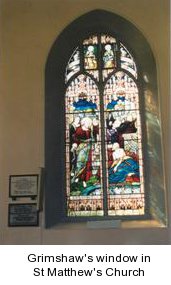Journal Volume 4 2004
A priest, an altar and a Window (continued/3)
A Window
In St Matthew's Church, Newtownmountkennedy, there is a lovely stained glass window which we call the  Grimshaw’s window. It depicts the healing of the lame man by our Lord at the Pool of Bethezda (St John, Ch 5). The inscription on the window is as follows:
Grimshaw’s window. It depicts the healing of the lame man by our Lord at the Pool of Bethezda (St John, Ch 5). The inscription on the window is as follows:
“In memory of Elizabeth Dorothia Grimshaw who worshipped in this church for nine years. Died August 17 1906. Also her husband Wrigley Grimshaw F.RC.S.I. died June 1878”.
Wrigley Grimshaw was Dental Surgeon to Steeven's and St Mark's Hospital and the Pitt St Institution for Diseases of Children in Dublin. The history of the Grimshaw family from the 13th century is given in Whittaker's “History of Whorley” and in “Lancashire's Worthies”. Dr Thomas Grimshaw, who erected this window, was born near Belfast in 1839. His great-grandfather had come from Lancashire and founded the Calico printing industry in Ireland using machinery for the spinners. He studied medicine and many other related disciplines at Trinity College Dublin, gaining many distinctions and honours. He was visiting physician to Steeven's Hospital, Cork St. Fever Hospital, National Hospital for Consumption at Newcastle, Co. Wicklow, Sir Patrick Dun's and was also a lecturer and writer of medical journals. In 1879 he was appointed Registrar-General for Ireland, which included overseeing the Census of 1881 and 1891. He was a member of two committees of enquiry:
- The Dietary of Irish Prisons
- The Sanitary conditions of the Royal Barracks.
Nothing new here in Irish Society except the costs involved!!
In 1897, the year of Queen Victoria's Diamond Jubilee, Thomas was awarded Companionship of the Bath. He married Sarah, daughter of Rev Thomas and they had a family of seven sons and two daughters. Some died at an early age while the others distinguished themselves in colonial service and three as officers in the Royal Dublin Fusiliers.
Perhaps Dr. Thomas Grimshaw's greatest achievement was in persuading the city authorities to install underground sewerage. With his close association with hospitals and widespread disease he was the ideal person to instigate a whole new system for the disposal of sewage. Before his intervention household waste and sewage was thrown into open surface drains that ran down to the Liffey. With his wide knowledge and research he found that cholera, typhoid and enteric fever were prevalent in the houses that adjoined open drains. He called them “fever nests”. Around this time clean water, replacing old water pumps, was available from the Vartry reservoir. A clean water supply and underground piped sewage made a vast improvement in the health and well being of the citizens of Dublin.
In recognition of his many talents and achievements the Tourist Board placed a plaque on 13 Molesworth St. in 1990 where he and his family lived for many years. The plaque says:
“Doctor Thomas Wrigley Grimshaw 1839 - 1900 Physician and Philanthropist Lived on this site 1861 – 1881”.
In the early nineteen eighties his great grandson Nicholas Thomas Grimshaw came to Dublin tolecture at University College on “Architecture, my life and Times”. “There were traffic jams”, he said, “because they were replacing some of the old sewage pipes from my great grandfather's time”. Digging up the roads and traffic jams is still with us in 2004!
A few years ago while on holiday in Cornwall I visited the now famous Eden Project described by many as the 8th Wonder of the World. It is a vast construction of three domes, the largest 200m long, 100m wide, and 57m high. It is the largest greenhouse in the world, hidden from view in china clay craters the area of 35 football pitches. Just like bees make their honeycombs, the domes are made of hexagons 625 in number and covered in 3 layers of transparent foil. Inside in controlled temperatures you can experience the life, climate and plants of seven contrasting countries, from a South American tropical rainforest to South Africa. Here you can see many growing plants that changed the world, fascinating plants that look after themselves, plants that make plastic and rubber, plants that make chocolate tea and chewing gum, and plants that move.
I was impressed, and looking at the literature I read that the architect was Nicholas Grimshaw. The name struck a chord with me and returning home made some enquiries and discovered that he was a great grandson of Dr Thomas Wrigley who had erected the stained glass window in St Matthew's. I wrote to him and sent him a photograph of the window, which he did not know existed. He replied saying that he was greatly interested to hear about his great grandfather's connection with St Matthew's church. Last year, he and his daughter, who is a student at Trinity College Dublin, visited St Matthew's and saw the window for themselves.
Earlier this year there was a photograph of Nicholas Grimshaw in the Daily Telegraph and other papers as he had been knighted for his design of the Eden project. It cost Sterling £80 million, has attracted over 2 million visitors and generated Sterling £120 million for the local economy. Sir Nicholas Grimshaw was also the architect of the Eurostar Terminal in London, which won Building of the Year award in 1994. He has also recently completed the new glass box development of the historic Spas in Bath. “We deliberately try to keep a low profile. Buildings ought to speak for themselves”, he modestly said. For the Grimshaw family, who, among other achievements introduced the first cotton spinners by machinery to Ireland, underground sewage to the city of Dublin and designed the Eden project in Cornwall it must be difficult to keep a low profile. Their achievements speak for themselves.


